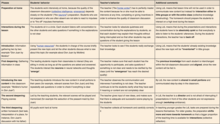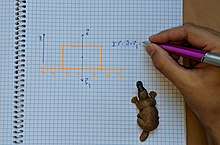Learning by teaching
In the field of pedagogy, learning by teaching (German: Lernen durch Lehren, short LdL) is a method of teaching in which students are made to learn material and prepare lessons to teach it to the other students. There is a strong emphasis on acquisition of life skills along with the subject matter. This method was originally defined by Jean-Pol Martin in the 1980s.
Background

The method of having students teach other students has been present since antiquity.[1] Most often this was due to lack of resources.[1] For example, the Monitorial System was an education method that became popular on a global scale during the early 19th century. It was developed in parallel by Scotsman Andrew Bell who had worked in Madras and Joseph Lancaster who worked in London; each attempted to educate masses of poor children with scant resources by having older children teach younger children what they had already learned.[2]
Systematic research into intentionally improving education, by having students learn by teaching began in the middle of the 20th century.[3]
In the early 1980s, Jean-Pol Martin systematically developed the concept of having students teach other in the context of learning French as a foreign language, and he gave it a theoretical background in numerous publications.[4] The method was originally resisted, as the German educational system generally emphasized discipline and rote learning.[1] However the method became widely used in Germany in secondary education, and in the 1990s it was further formalized and began to be used in universities as well.[4] By 2008 Martin had retired, and although he remained active Joachim Grzega took the lead in developing and promulgating LdL.[1][5]
Method

After preparation by the teacher, students become responsible for their own learning and teaching. The new material is divided into small units and student groups of not more than three people are formed.[1]
Students are then encouraged to experiment to find ways to teach the material to the others. Along with ensuring that students learn the material, another goal of the method, is to teach students life skills like respect for other people, planning, problem solving, taking chances in public, and communication skills.[7][8][9][10] The teacher remains actively involved, stepping in to further explain or provide support if the teaching-students falter or the learning-students do not seem to understand the material.[1]
The method is distinct from tutoring in that LdL is done in class, supported by the teacher, and distinct from student teaching, which is a part of teacher education.[4]
Plastic platypus learning

A related method is the plastic platypus learning or platypus learning technique. This technique is based on evidence that show that teaching an inanimate object improves understanding and knowledge retention of a subject.[11] [12][13] The advantage of this technique is that the learner does not need the presence of another person in order to teach the subject.
The name 'plastic platypus learning' is a paraphrase on the known software engineering technique rubber duck debugging, in which a programmer can find bugs in their code without the help of others, simply by explaining what the code does, line by line, to an inanimate object - namely, a rubber duck.[14] Obviously, this technique may work with any inanimate object, and not just plastic platypuses.
See also
- Active learning – Educational technique
- Jigsaw (teaching technique)
- Learning theory (education)
- The Aha! effect – Human experience of suddenly understanding a previously incomprehensible problem or concept
- Think aloud protocol
References
- Heinrich, Christian (November 2007). "Learning by Teaching: The Goal is Independence". Goethe-Institut.
- Graves, Frank Pierrepont (1915). A Student's History of Education. Macmillan Company. pp. 239ff.
- Gartner, Alan; Kohler, Mary Conway; Riessman, Frank (1971). Children teach children; learning by teaching (1st ed.). New York: Harper & Row. ISBN 978-0-06-013553-9.
- Safiye, Aslan (October 5, 2015). "Is Learning by Teaching Effective in Gaining 21st Century Skills? The Views of Pre-Service Science Teachers". Educational Sciences: Theory and Practice. 15 (6). ISSN 1303-0485.
- "About me" (in German). Jean-Pol Martins Weblog. 11 November 2008. Retrieved 10 June 2018.
- Kahl, von Reinhard (2005). Treibhäuser der Zukunft wie in Deutschland Schulen gelingen ; eine Dokumentation (2nd, überarb. Aufl. ed.). Berlin: Archiv der Zukunft [u.a.] ISBN 978-3-407-85830-6.
- Thimm, Katja (1 July 2002). "Guten Morgen, liebe Zahlen". Der Spiegel.
- Kahl, Reinhard (October 22, 2008). "Unterricht: Schüler als Lehrer". Zeit (in German).
- Stollhans, S. (2016). "Learning by teaching: developing transferable skills." (PDF). In Corradini, E.; Borthwick, K.; Gallagher-Brett, A. (eds.). Employability for languages: a handbook. Dublin: Researchpublishing.net. pp. 161–164. doi:10.14705/rpnet.2016.cbg2016.478. ISBN 978-1-908416-39-1.
- Grzega, Joachim; Schöner, Marion (4 July 2008). "The didactic model LdL (Lernen durch Lehren) as a way of preparing students for communication in a knowledge society". Journal of Education for Teaching. 34 (3): 167–175. doi:10.1080/02607470802212157.
- "Learning by teaching others is extremely effective – a new study tested a key reason why". 2018-05-04.
- Aslan, Safiye (2015). "Is Learning by Teaching Effective in Gaining 21st Century Skills? The Views of Pre-Service Science Teachers". Educational Sciences: Theory & Practice. 15 (6). doi:10.12738/estp.2016.1.0019.
- Bargh, John A.; Schul, Yaacov (1980). "On the cognitive benefits of teaching". Journal of Educational Psychology. 72 (5): 593–604. doi:10.1037/0022-0663.72.5.593.
- Koh, Aloysius Wei Lun; Lee, Sze Chi; Lim, Stephen Wee Hun (2018). "The learning benefits of teaching: A retrieval practice hypothesis". Applied Cognitive Psychology. 32 (3): 401–410. doi:10.1002/acp.3410.
Further reading
- Grzega, Joachim; Klüsener, Bea (15 May 2011). "Learning by Teaching through Polylogues: Training Expert Communication in Information and Knowledge Societies Using LdL (Lernen durch Lehren)". Fachsprache. 33 (1–2): 17–35. doi:10.24989/fs.v33i1-2.1379.
- Krüger, Rudolf (1975). Projekt Lernen durch Lehren : Schüler als Tutoren von Mitschülern. Bad Heilbrunn (Obb.): Klinkhardt. ISBN 978-3-7815-0243-7.
- Martin, Jean-Pol (1985). Zum Aufbau didaktischer Teilkompetenzen beim Schüler : Fremdsprachenunterricht auf der lerntheoretischen Basis des Informationsverarbeitungsansatzes. Tübingen: Narr. ISBN 978-3-87808-435-8.
- Martin, Jean-Pol (1994). Vorschlag eines anthropologisch begründeten Curriculums für den Fremdsprachenunterricht. Tübingen: Narr. ISBN 978-3-8233-4373-8.
- Martin, Jean-Pol (2018). "Lernen durch Lehren: Konzeptualisierung als Glücksquelle". In Burow, Olaf-Axel; Bornemann, Stefan (eds.). Das Große Handbuch Unterricht & Erziehung in der Schule (in German) (1 ed.). Link, Carl. pp. 345–360. ISBN 9783556073360.
- Martin, Jean-Pol; Oebel, Guido (2007). "Lernen durch Lehren: Paradigmenwechsel in der Didaktik?". Deutschunterricht in Japan. 12: 4–21. ISSN 1342-6575. (Author copy)
- Schelhaas, Christine (2003). "Lernen durch Lehren" für einen produktions- und handlungsorientierten Fremdsprachenunterricht : ein praktischer Leitfaden mit zahlreichen kreativen Unterrichtsideen und reichhaltiger Materialauswahl (2nd, verb. Aufl. ed.). Marburg: Tectum-Verl. ISBN 978-3-8288-8548-6.
- Skinner, Jody (June 3, 2018). "The Koblenz Model within Anglo-American Cultural Studies at German Universities". Developing Teachers.
- Frick, Rosmarie (September 2005). "Students teach each other literature ( lernen durch lehren): Working with "The Curious incident of the dog in the night-time"". Humanising Language Teaching. 7 (5).